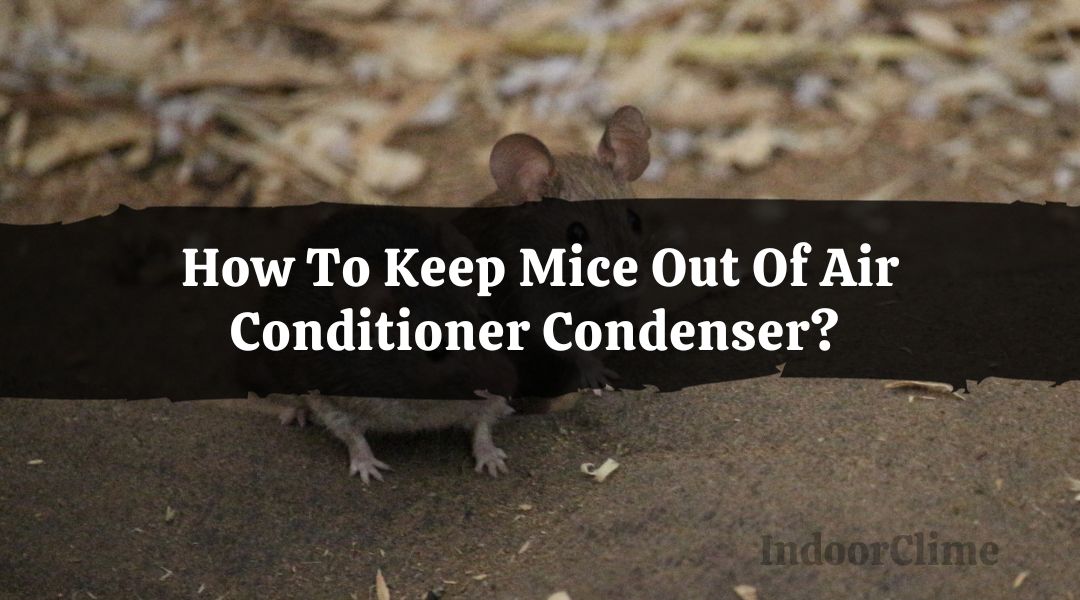Mice have a knack for sneaking inside places into almost any environment, and the path of ruin they leave behind is rarely more apparent — or more expensive to repair — than when they wreck your HVAC or air conditioning machine.
To keep the mice out of your air conditioner, taping up ducts and replacing cables are the easiest methods to deal with a mouse infestation, whether in your HVAC, air conditioner, or elsewhere and to prevent it from happening in the first place.
In this article, we’ll explain why mice like air-conditioned areas and a step-by-step guide on keeping mice out of your air conditioner condenser.
Do Mice Like Air Conditioning?
Yes. Mice are drawn to the shelter provided by HVAC and air conditioning systems and begin creating a home there immediately.
According to experts, the optimal temperature for mice inside a house is between 68 and 80 degrees Fahrenheit, while they can comfortably live in temperatures ranging from 80 to 89 degrees Fahrenheit outside.
An air-conditioned space is ideal for mice because of this factor. They can also get food in a house’s main room with little effort.
Mice will be attracted to your home for three reasons:
1. Shelter
Mice seek safety and warmth inside homes as the temperature cools and winter approaches.
2. Food
Mice require consistent food sources to survive. This implies they’ll set up shop anywhere there’s enough food.
3. Nesting materials
Mice are attracted to your HVAC system because of the insulation it contains. It’s cozy and provides a secure environment for nesting. Mice build nests to give birth to and raise their young.
They like soft materials like shredded paper and cotton but also utilize pet hair, insulation, etc.
Can Mice Get Through Air Vents?

Yes. Mice can get via air vents and pass through gaps, fissures, and wholes as broad as a quarter with relative ease. Mice have extremely flexible limbs, maximizing their mobility while entering a space.
- Because mice exploit access sites, they frequently end up in new places.
- Because laypeople’s eyes aren’t trained enough to identify a gap prone to rat invasions, it’s difficult for them to combat a mouse infestation effectively.
- An air conditioner is ideal because the air ducts include items that mice can use to make suitable nests.
You must first comprehend how they gain access. Mice can squeeze themselves into the tiniest of spaces. Mice can climb and squeeze through tiny holes and crevices.
Most people don’t realize how adaptable mice are. They can pass through air vents, fissures, and holes with ease.
Mice can readily infest air vents, scattering excrement and urine, jeopardizing functionality and components.
- Interior air vents with louvered, angled, or grid apertures smaller than a nickel will not allow a rodent to fit through.
- If they are large enough, broken, or have gaps in the protective screens, fresh air intake vents, and external air vents might be access opportunities.
- If not adequately screened or covered, mice and rats can access the attic and crawl space vents.
Mice are more acrobatic than people realize; they can readily climb elevated surfaces, explaining why mice are so standard in homes.
To fit through a hole, mice only need a quarter’s diameter; thus, an air vent would be simple. Their teeth are strong, so they can easily gnaw through the plastic vent covers.
Why Do Mice Stay In AC Condenser?
If your air conditioner condenser is adequately shaded and surrounded by a pleasant environment, the possibility of mice infesting the unit will grow fast.
A shelter will entice them to build a home within the department and live without internal or exterior problems.
Mice, in particular, are attracted to these areas because they give the warmth and safety that mice seek as the winter months approach.
How To Mouse-proof an Air Conditioner?
To keep mice out of your HVAC or air conditioning unit, follow these steps:
1. Pest proofing

Whether you have a pest problem, pest-proofing is something you should undertake. Because there are a variety of other animals that would like to live in your air conditioner, pest-proofing should be part of your routine maintenance.
Pest-proofing can be done in a variety of ways. The following are just a few strategies to keep mice and other pests out of your air conditioner and out of your house:
-
Install covers
Install flue coverings and air vents. Mice and other critters will be kept from your ducting with mesh screens or specific covers. Air vents and flues can be covered with customized covers and mesh screens for AC systems.
Ensure your vents and flue pipes are covered to keep mice out of your house. If you notice a fracture or duct, fix it immediately because mice can enter through air vent cracks and chimneys.
-
Seal entry points
A mouse can quickly enter your home through the air ducts of your air conditioner. Seal any cracks or holes in the vents to keep mice out and repair damaged ducts. Mice can squeeze through a hole half the nickel size, so ensure your air ducts are securely sealed to keep mice out.
Air ducts should be sealed since gaps, cracks, and holes invite pests into your HVAC system.
-
Prevent moisture
Pests such as mice will attack the AC unit because of moisture buildup around it. The dampness gives them something to drink, and mice must stay hydrated. Redirect puddles from rain or condensation that accumulate around the device to keep it dry.
-
Guard your condenser
Mice and other rodents commonly enter your air conditioner through the air vents. Therefore, remove all plants from the area around the unit, especially any stacked materials near the AC, as they may attract mice.
Repeat this routine regularly and throughout the year. However, during the seasons when your air conditioning system is not operating, you need to be particularly cautious because they are more likely to attack.
2. Keep the AC Clean

Maintain a clean environment surrounding your outside air conditioning equipment and weeding to avoid attracting mice and other pests.
Also, remove any standing water near the external unit, which might attract mice and other problems.
3. Remove all potential food sources nearby
Mice only require modest amounts of food daily. Remove the foods they prefer to eat from your home to eliminate them. All grains, pet food, and other dry commodities should be stored in glass or metal containers, which mice cannot nibble through.
4. Remove all nesting materials nearby
Store all fabric, carpets, and blankets in heavy-duty plastic storage boxes to keep mice from stumbling upon soft nesting materials.
Mice will gnaw through cardboard, paper, or lightweight plastic to build nests, so dispose of your recyclables quickly.
Pay attention to the exterior of your house as well. Keep your property clean and clear of waste on the interior and outdoors by removing vegetation and tree branches within three feet of the foundation.
5. Use a natural mouse deterrent

Mice have a sophisticated sense of smell, which you can use. Consider these natural mouse repellents:
- Essential oils
- Apple cider and water
- Fabric softener sheets
6. Contact a professional pest control company

Ask your local pest control provider for assistance. Dealing with mice in your air conditioner is a significant headache. Dealing with them using your air conditioning to enter your home is even more difficult.
Fortunately, keeping them out of your home’s air conditioner is straightforward. Contact a pest control professional if you require more assistance removing mice from your air conditioning unit.
To review your pest control procedures and supplement them with their own, pest management professionals frequently collaborate with other service providers, such as HVAC maintenance specialists, in this situation.
Regularly servicing and repairing your HVAC or air conditioning equipment will help make the overall system less appealing to mice and other pests.
Once a year, get the system inspected by a specialist. Ensure the technician cleans the components and inspects the condenser, vents, and duct system for evidence of pest activity.
How Do You Seal a Wall Around an Air Conditioning Hose To Keep Pests?
1. Caulk
Use caulk to seal a wall around your air conditioning hose to keep out pests. Caulk the cracks in the wall to keep bugs out. Acrylic caulk is easy to use and fills small holes up to a quarter-inch in diameter. Acrylic caulk is long-lasting, but it does shrink over time.
Because of this, it is unsuitable for significant gaps. Other caulks, such as polyurethane, fill more significant gaps because of their superior adherence, but they are difficult to apply since they do not smooth smoothly.
2. Insulation foam
Insulation foam with a low expansion rate covers openings in walls but does not leave a smooth finish. It is messy to apply and clean but forms a tight seal when it expands to fill wall gaps.
Choose a caulk or filler depending on the hole’s size and the desired appearance.
3. Metal collar
Put a metal collar around the hole, fill the gap with steel wool, or cover the aperture with a wire screen to keep rats out. Though these tactics deter rodents, they may not block cold air or insect pests.
A combined seal will keep both insects and rats out. First, fill the hole or gap with wire mesh or screen, then apply caulk over the screen to prevent insects and energy loss.
4. Proofing pads
Because steel wool rusts and stains walls, look for stainless steel or copper rodent-proofing pads at your local home improvement store.
These treatments work around access holes, pipes, and other pest-prone spots outside and inside the house. Pick up glue traps while you’re at the center.
The sticky traps will catch rats if you accidentally seal them inside the house. The traps, unlike poison, prevent vermin from crawling away and rotting inside a wall or attic.
What is a mouse repellent?
Extra-Strength Mouse Repellent
A mouse repellent is a product that can keep the mice away from a certain place. Several kinds of mouse repellent include DIY solutions and plant-based mixtures. Some products can be bought in the market as mouse repellents.








